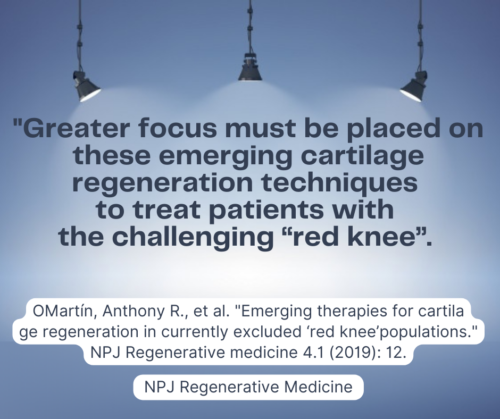
Has your physician said you’re not a knee surgical candidate? If so, now what can you do? And what happens to those referred to as “red knees” or patients who are not candidates for surgery? Fortunately, there are alternatives for the red knee, non-surgical candidate.
The high prevalence of joint injury and the healing ability of joint tissue poses a significant challenge for the orthopedic medical community. Even when the patient is young and healthy, injury puts the patient on the road to degenerative arthritis. But in older patients with ligament instability, arthritis, or systemic disease, the challenge is much more significant, and the options for joint repair are significantly limited. This population of patients is often categorized as “red knees.”
The knee injuries of young and healthy patients planning for surgery may be referred to as “green knees” due to the age and health of the patient. Patients with “green knees” are commonly included in clinical trials because they have the highest probability of success. But even in these patients, the standard surgical options and arthroscopic repair fall short.
Those with “red knees” are patients with cartilage pathologies that are more severe, and those who have co-morbidities that exclude them from the more common surgical procedures. Often, these “red knee” patients are only given palliative treatments such as cortisone, NSAIDs, and hyaluronic acid injections. These treatments are not reparative but only provide possible relief for a few months. These “red knee” patients are often neglected and are generally only given the recommendation for an eventual joint replacement.
Regenerative Orthopedics provides a non-surgical answer for both the green and red knee populations. Dextrose Prolotherapy injections may be sufficient for younger patients to repair a knee injury. PRP may also be recommended for certain knee injuries, like meniscus tears. And then, when injuries or degeneration are more severe, Stem Cells may be recommended. All of these procedures are non-surgical, in-office procedures.
Age is the main reason patients are categorized as “red knees, ” excluding them from clinical trials. But regarding Regenerative Orthopedics, age does not prohibit the patient from receiving or benefiting from treatments. Many of our patients are older and they have had successful reparation of their knees and/or other joints. Another common exclusion due to “red knees” is the presence of arthritis. But “red knee” patients with arthritis can still benefit from these regenerative therapies.
Ligament instability is another criterion for categorizing a “red knee” patient. Fortunately, Regenerative Orthopedics is the treatment of choice to repair ligament instability. Once an injury occurs, early treatment with regenerative therapies would be beneficial before the joint becomes arthritic.
In previous articles, we discussed the joint instability process that occurs once the joint tissue structures, such as the ligaments and tendons, are injured. Basically, these structures get weaker and “lax” once injured. The ligament and tendon laxity allows for abnormal movement in the joint. It’s similar to a cabinet hinge that has some screws loose. When the screws and hinge are loose, the cabinet becomes wobbly. When a joint becomes “wobbly,” the joint moves abnormally. With abnormal joint motion, the joint structures begin to degenerate.
Regenerative Orthopedics, like Prolotherapy, PRP, and Stem Cells, stabilize, strengthen, and repair the joint. These are the best treatments for joint instability, as they repair the injured and lax ligaments and tendons. Plus, they are regenerative in nature and allow for joint repair even in cases of arthritis.
Regenerative Orthopedics offers hope for the “red knee” population and an alternative to knee replacement.
Don’t hesitate to call us at 310-453-1234 and find out if you are a candidate.